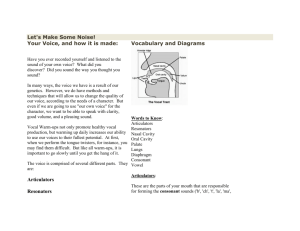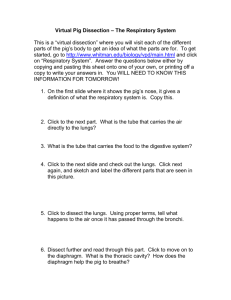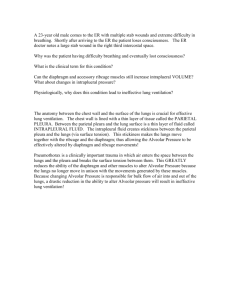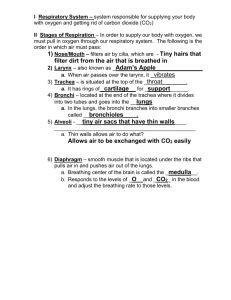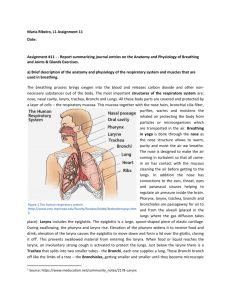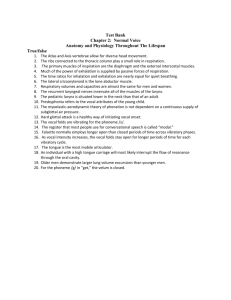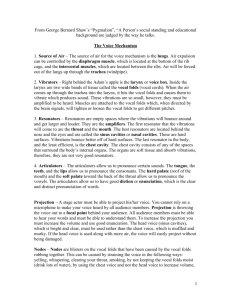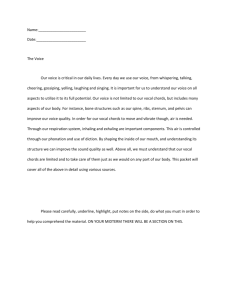ANATOMY OF THE VOICE
advertisement
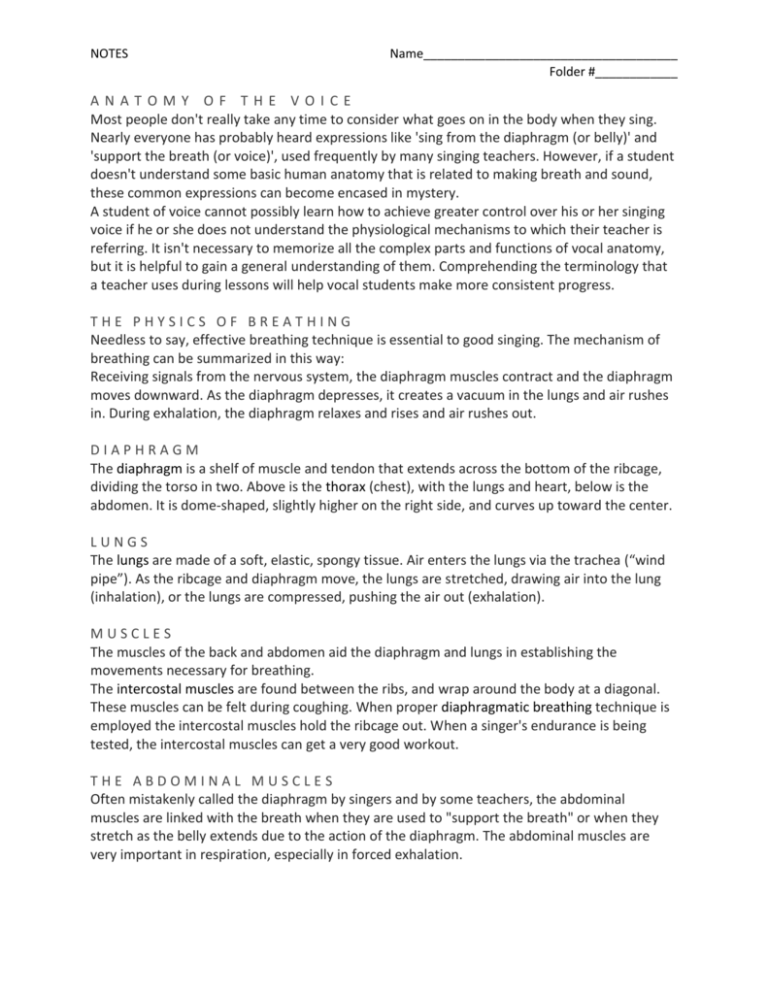
NOTES Name_____________________________________ Folder #____________ ANATOMY OF THE VOICE Most people don't really take any time to consider what goes on in the body when they sing. Nearly everyone has probably heard expressions like 'sing from the diaphragm (or belly)' and 'support the breath (or voice)', used frequently by many singing teachers. However, if a student doesn't understand some basic human anatomy that is related to making breath and sound, these common expressions can become encased in mystery. A student of voice cannot possibly learn how to achieve greater control over his or her singing voice if he or she does not understand the physiological mechanisms to which their teacher is referring. It isn't necessary to memorize all the complex parts and functions of vocal anatomy, but it is helpful to gain a general understanding of them. Comprehending the terminology that a teacher uses during lessons will help vocal students make more consistent progress. THE PHYSICS OF BREATHING Needless to say, effective breathing technique is essential to good singing. The mechanism of breathing can be summarized in this way: Receiving signals from the nervous system, the diaphragm muscles contract and the diaphragm moves downward. As the diaphragm depresses, it creates a vacuum in the lungs and air rushes in. During exhalation, the diaphragm relaxes and rises and air rushes out. DIAPHRAGM The diaphragm is a shelf of muscle and tendon that extends across the bottom of the ribcage, dividing the torso in two. Above is the thorax (chest), with the lungs and heart, below is the abdomen. It is dome-shaped, slightly higher on the right side, and curves up toward the center. LUNGS The lungs are made of a soft, elastic, spongy tissue. Air enters the lungs via the trachea (“wind pipe”). As the ribcage and diaphragm move, the lungs are stretched, drawing air into the lung (inhalation), or the lungs are compressed, pushing the air out (exhalation). MUSCLES The muscles of the back and abdomen aid the diaphragm and lungs in establishing the movements necessary for breathing. The intercostal muscles are found between the ribs, and wrap around the body at a diagonal. These muscles can be felt during coughing. When proper diaphragmatic breathing technique is employed the intercostal muscles hold the ribcage out. When a singer's endurance is being tested, the intercostal muscles can get a very good workout. THE ABDOMINAL MUSCLES Often mistakenly called the diaphragm by singers and by some teachers, the abdominal muscles are linked with the breath when they are used to "support the breath" or when they stretch as the belly extends due to the action of the diaphragm. The abdominal muscles are very important in respiration, especially in forced exhalation. NOTES Name_____________________________________ Folder #____________ SUPPORT Support works by contracting the abdominal muscles, creating higher pressure in the abdomen and chest, allowing the diaphragm's relaxation to be more carefully controlled. Support gives performers a way of controlling their sound. When singing, relax the abdominal muscles as much as possible during inhalation and support the breath by tightening the abdomen during sound production. Ultimately, a singer wants access to all the "breath resources" available freely produce sound without unnecessary tension. PHYSICS OF MAKING SOUND When air is released from the lungs, it rises up the trachea (“wind pipe”) and runs into at the larynx - where the vocal folds, are housed - causing the vocal folds to vibrate or buzz and make sound. The vocal folds 'chop' the air stream up into a series of rapid 'puffs' that create the sound. The resulting sound is modified by movements in the vocal tract, where sound that is produced at the larynx, pharynx, and mouth/nasal cavities is altered. During speech the flow of air is relatively small because of constrictions of the vocal folds. RESONATION (VIBRATION) The buzz created by the vocal folds resonates (vibrates) the air column and this causes the structures above and around the larynx to vibrate, as well. The parts of the body that can vibrate in harmony with the voice are often called resonators. The following areas resonate with the air column: Chest- low notes (“chest voice”) and open sounds, like 'ah' Throat and Mouth Nasal - closed, front vowels, especially nasal consonants such as 'n' or 'm' Facial - high range, front vowels Sinuses Bones and Skull – falsetto (“head voice”), very high notes, closed vowels. Voice teachers use the term 'placement' in reference to where one feels the sound vibrate or “resonate” in the body. ARTICULATION (THE CREATION OF SPECIFIC SPEECH SOUNDS) Finally, air and vibration pass through the vocal tract and are shaped by the articulators into recognizable speech sounds. Movable articulators are structures that can move and allow us to shape the sound such as the jaw, the lips and other facial muscles, the tongue, the soft palate - the soft, movable tissue constituting the back of the roof of the mouth - and the pharynx. Fixed articulators are those that cannot be moved by muscles, namely the hard palate and teeth. The hard palate is a thin, horizontal bony plate of the skull, located in the roof of the mouth, which spans the arch formed by the upper teeth. It forms a partition between the nasal passages and the mouth.
